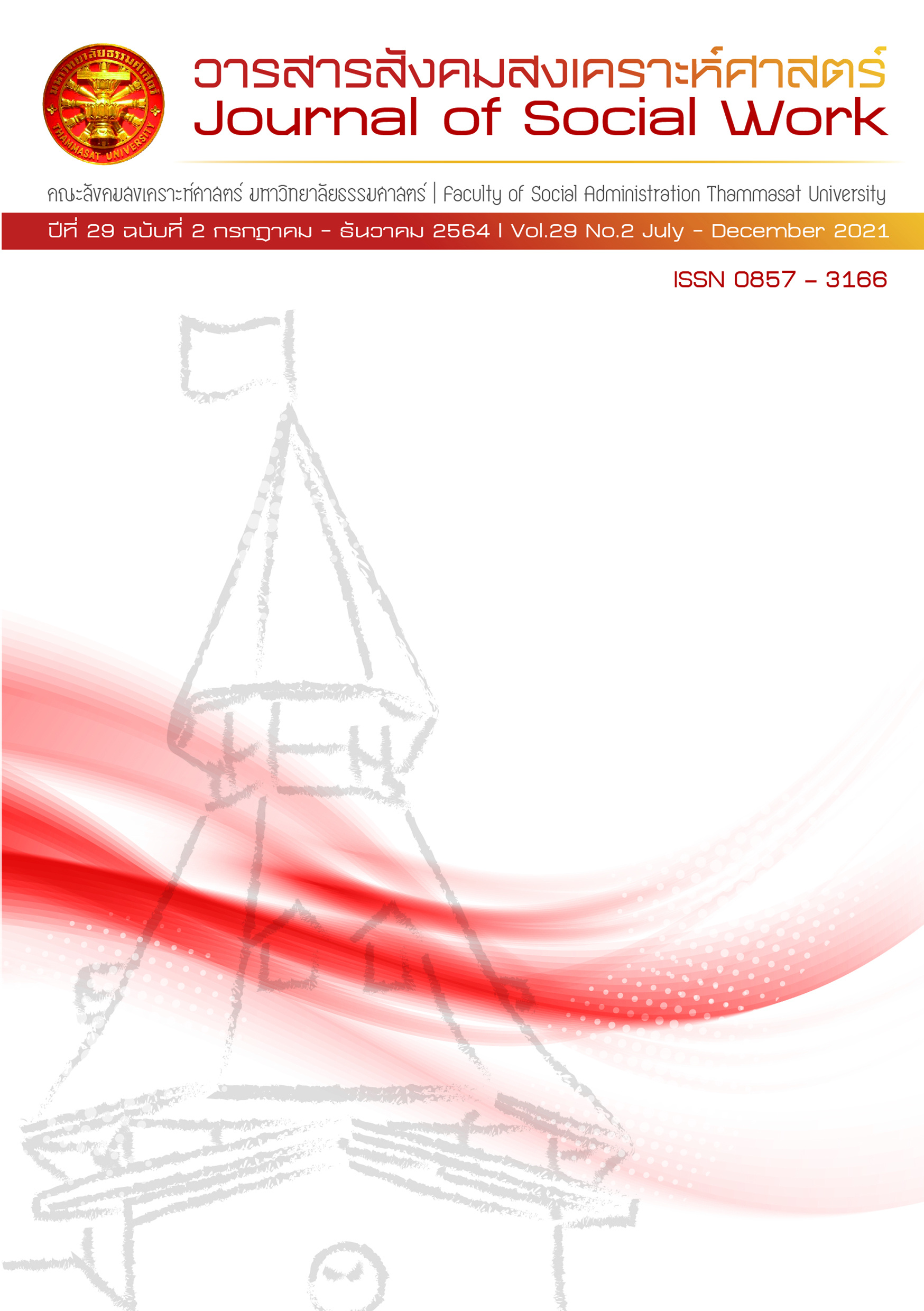Conditions and Impacts of Burnout in Child Protective Service Workers
Keywords:
Conditions, Impacts, Burnout, Child protective service workersAbstract
This research applies a qualitative research case study method aiming to study the conditions and impacts of burnout of child protective service workers. Purposive sampling has been used in this study. The key Informants consist of five high burnout score child protective services workers in public and private child welfare organizations who have experience of working with abused children for more than a year. Data was collected through in-depth interviews and participant observation. Triangulation was used as a validation through content analysis.
The results reveal that the conditions of burnout in child protective service workers are 1) personal conditions including personality, attitude, education, work experiences, and family, and 2) work conditions including workplace, job functions related to working towards helping child abuse, workload and high responsibility, and conflict of roles, personal relationship, and organizational system in which the system and manager do not support this job, lack of career advancement and low pay, and lack of crew front line and miss encourage staff. As mentioned above, these conditions result in a lack of work satisfaction and motivation among children protective service workers. Burnout of child protective service workers will affect 1) the physical and mental health and behaviors of workers who help abused children as they risk depression and are experiencing compassion fatigue, 2) abused children who might receive a lower quality of services, and colleagues and family members who are experiencing relationship problems with workers, and 3) organizations that would receive a lower quality of work and lose efficient workers.
References
กระทรวงการพัฒนาสังคมและความมั่นคงของมนุษย์. (2559). รายงานข้อมูลสถานการณ์ด้านความรุนแรงในครอบครัวสำหรับการรายงานตามมาตรา 17 แห่งพระราชบัญญัติคุ้มครองผู้ถูกกระทำความรุนแรงในครอบครัว พ.ศ. 2550 ประจำปี 2558. สืบค้นจาก http://library2.parliament.go.th/giventake/content_nla2557/d120859-06.pdf
กามัน เจ๊ะอารง และ ชญานิกา ศรีวิชัย. (2560). ความสัมพันธ์ระหว่างปัจจัยสภาพแวดล้อมในการทำงานกับความเหนื่อยหน่ายของพยาบาลวิชาชีพที่ปฏิบัติงานโรงพยาบาลชุมชน จังหวัดปทุมธานี. วารสารพยาบาลทหารบก, 18, 299-305.
ติรยา เลิศหัตถศิลป์. (2554). ภาวะเหนื่อยล้าในการทำงานและปัจจัยที่เกี่ยวข้องของจิตแพทย์ในประเทศไทย. วารสารสมาคมจิตแพทย์แห่งประเทศไทย, 56(4), 437-448.
ทมาภรณ์ สุขสวรรค์, กิ่งแก้ว แสงสว่าง และ พิมพ์พิมล เรืองฤทธิ์. (2554). ความสัมพันธ์ระหว่างปัจจัยด้านการปฏิบัติงาน ปัจจัยด้านครอบครัวและสังคมกับภาวะเบื่องานของอาจารย์พยาบาลวิทยาลัยพยาบาลเครือข่ายภาคเหนือ สังกัดสถานบันพระบนมราชชนก. วารสารวิจัยทางวิทยาศาสตร์สุขภาพ, 5(1), 40-47.
ทรียาพรรณ สุภามณี, วิภาดา คุณาวิกติกุล และ ผ่องศรี เกียรติเลิศนภา. (2557). การปฏิบัติงานเกินเวลาของพยาบาลและผลลัพธ์ด้านพยาบาลในโรงพยาบาลชุมชน. พยาบาลสาร, 41, 48-50.
เบญจมา ณ มหาไชย. (2551). การรับรู้ความยุติธรรมในองค์การ ปัจจัยความเครียดในการทำงานความสามารถในการเผชิญและฟันฝ่าอุปสรรคและความเหนื่อยหน่ายจากการทำงานของบุคลากรมหาวิทยาลัยในกำกับรัฐบาล. วิทยานิพนธ์ปริญญามหาบัณฑิต, สาขาวิชาจิตวิทยาอุตสาหกรรมและองค์การ, คณะศิลปะศาสตร์, มหาวิทยาลัยธรรมศาสตร์.
เบญญทิพย์ เหมือนหมาย. (2561). ความสัมพันธ์ระหว่างความไม่สมดุลของความพยายามในการทำงานกับผลตอบแทนและความเหนื่อยหน่ายทางอารมณ์ของพนักงานสำนักงานกลุ่มเจนเนอเรชั่นวายในจังหวัดเชียงใหม่: บทบาทการเป็นตัวแปรปรับของการสนับสนุนทางสังคม. วิทยานิพนธ์ปริญญามหาบัณฑิต, สาขาวิชาจิตวิทยาอุตสาหกรรมและองค์การ, คณะมนุษยศาสตร์ มหาวิทยาลัยเชียงใหม่.
ปรารถนา เล็กสมบูรณ์. (2554). ความเครียดในงาน การเผชิญปัญหา และความเหนื่อยหน่ายในงานของผู้ปฏิบัติการช่วยเหลือในสถานสงเคราะห์ของรัฐบาล: การวิจัยแบบผสานวิธี. วิทยานิพนธ์ปริญญามหาบัณฑิต, สาขาจิตวิทยาการปรึกษา, คณะจิตวิทยา, จุฬาลงกรณ์มหาวิทยาลัย.
วิไล เสรีสิทธิพิทักษ์. (2550). ภาวะหมดไฟ: ความหมาย แบบทดสอบ และแนวทางป้องกันแก้ไข. วารสารสถาบันจิตเวชศาสตร์สมเด็จเจ้าพระยา, 1, 121-130.
สำนักงานคณะกรรมการกฤษฎีกา. (2547). ระเบียบกระทรวงการพัฒนาสังคมและความมั่นคงของมนุษย์ว่าด้วย วิธีการดำเนินงานของสถานแรกรับสถานสงเคราะห์สถานคุ้มครองสวัสดิภาพ และสถานพัฒนาแลฟื้นฟู พ.ศ. 2547. สืบค้นจาก http://law.m-society.go.th/law2016/law/view/18
สำนักส่งเสริมการพัฒนาเศรษฐกิจสังคมและการมีส่วนร่วม. (ม.ป.ป.). คู่มือการดำเนินงานช่วยเหลือผู้ประสบปัญหาของ oscc ศูนย์ช่วยเหลือสังคม.
อรสา ใจจินา. (2556). อิทธิพลของปัจจัยส่วนบุคคล และการสนับสนุนทางสังคมต่อความเหนื่อยหน่ายในการปฏิบัติงานของบุคลากรสาธารณสุขผู้รับผิดชอบงานสุขภาพจิตและจิตเวช ในพื้นที่เครือข่ายสุขภาพที่ 3. วารสารวิชาการศิลปศาสตร์ประยุกต์, 6(1), 2-8.
Ahola, K., & Hakanen, J. (2008). Job strain, burnout, and depressive symptoms: A prospective study among dentists. Journal of affective disorders, 104(1-3), 103-110.
Brady, P.Q. (2016). Crimes Against Caring: Exploring the Risk of Secondary Traumatic Stress, Burnout, and Compassion Satisfaction Among Child Exploitation Investigators. Journal of Police and Criminal Psychology, 32, 305–318.
Conrad, D., & Kellar-Guenther, J. (2006). Compassion fatigue, burnout, and compassion satisfaction among Colorado child protection workers. Child Abuse & Neglect, 30(10), 1071-1080.
Daley, M. R. (1979). Preventing worker burnout in child welfare. Child welfare, 58(7), 443-50.
Edward, F., and Wildeman, C. (2018). Characteristics of the front-line child welfare workforce. Children and Youth Services Review, 89, 13-26.
Figley, C. R. (2002). Compassion fatigue: Psychotherapists' chronic lack of self-care. Journal of clinical psychology, 58(11), 1433-1441.
Harrison, W. D. (1980). Role strain and burnout in child-protective service workers. Soc Serv Rev, 54(1), 31-34.
Jayaratne, S., Chess, W. A., & Kunkel, D. A. (1986). Burnout: Its Impact on Child Welfare Workers and Their Spouses. Social Work, 31(1), 53–59.
Känel, R. V. (2008). The burnout syndrome: A medical perspective. Praxis 97(9), 477-87.
Kim, H. (2011). Job conditions, unmet expectations, and burnout in public child welfare workers: How different from other social workers?. Children and Youth Services Review, 33(2), 358-367.
Leake, R., Rienks, S., & Obermann, A. (2017). A Deeper Look at Burnout in the Child Welfare Workforce. Human Service Organizations: Management, Leadership & Governance, 41(5), 492–502.
Lee, F. J., Stewart M., & Brown, Y. B. (2008). Stress, burnout, and strategies for reducing them. What’s the situation among Canadian family physicians?. Canadian Family Physician, 54(2) 234-235.
Lee, H. F., Yen, M., Fetzer, S., & Chien, T. W. (2015). Predictors of Burnout among Nurse in Taiwan. Community Ment Health, 51, 733-737.
Maslach, C. (1986). Maslach burnout inventory manual (2nd ed). CA: Consulting psychologist press.
Maslach, C., & Jackson, S. E. (1981). The measurement of experienced burnout. Journal of occupational behavior, 2(2), 99-133.
Maslach, C., Schaufeli, W. B., & Leiter, M. P. (2001). Job burnout. Annual Review of Psychology, 52, 397–422.
Maslow, A. H. (1970). Motivation and Personality. NY: Harper and Row.
Muldary, T. W. (1983). Burnout & health professionals: Manifestations & management. San Juan Capistrano, CA: Capistrano Press.
Nissly, J. A., Mor, Barak, M. E., & Levin, A. (2008). Stress, Social Support, and Workers' Intentions to Leave Their Jobs in Public Child Welfare. Administration in Social Work, 29(1), 79-100.
Passmore, S., Hemming, E., McIntosh, H. C., & Hellman, C. M. (2020). The Relationship Between Hope, Meaning in Work, Secondary Traumatic Stress, and Burnout Among Child Abuse Pediatric Clinicians. The Permanente journal, 24(1), 29-34.
Pines, A., & Aronson, E. (1983). Combatting burnout. Children and Youth Services Review, 5(3), 263-275.
Rossi et al. (2012). Burnout, compassion fatigue, and compassion satisfaction among staff in community-based mental health services. Psychiatry Research, 200(2–3), 933-938.
Downloads
Published
How to Cite
Issue
Section
License
The manuscripts published in the Social Work Journal is the copyright of the Social Work Journal, Thammasat University
Any article or opinion appeared in the Social Work Journal will solely be under the responsibility of the author The Faculty of Social Administration, Thammasat University and the editors do not need to reach in agreement or hold any responsibility.



